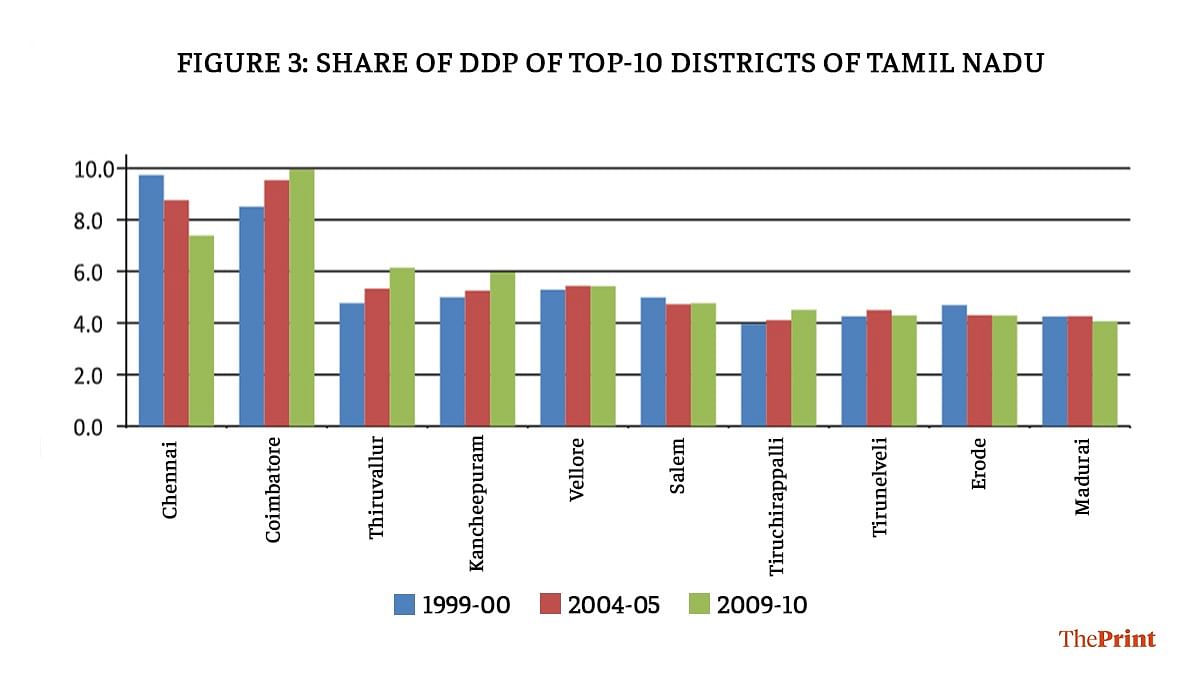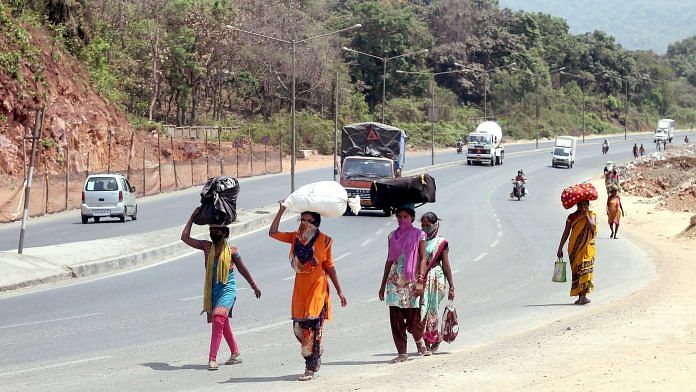The Covid-19 pandemic has brought the focus back on ‘unbalanced’ regional development among Indian states. As large industrial states recover from a badly hit economy, governments must keep in mind that the same old development model cannot be applied. A recent study showed how India’s prosperous states such as Gujarat, Maharashtra, Karnataka, and Tamil Nadu rely on manufacturing and high-tech services, while farming contributes only 10-15 per cent to their economies.
But substantial economic inequality is only one side of the story. There is another view to it — that of an even higher degree of intra-state disparity.
To capture this, we looked at the share of a district’s income in the state’s economy to bring out inter-district disparity for three of the most prosperous Indian states: Maharashtra, Karnataka, and Tamil Nadu. The new post-pandemic policy thinking should address the important point of regional disparity that data reveals.
In general, any discussion about economic disparity is usually restricted to two aspects: 1) comparison of per-capita income across major Indian states, and 2) the sectoral contribution in the state’s economy. An important reason for this is the easy availability of State Domestic Product (SDP) and various sectors (like agriculture, industry, and services) that contribute to it. The District Domestic Product (DDP) started becoming available only since the late 2000s. Also, the comparison across states is questionable given differing methodologies employed by statistical agencies of the state governments.
Also read: Manufacturing or high-tech? This is what India’s most prosperous states focus on
Inter-state geography of growth
We take DDP data from the Department of Economics and Statistics (DES) of Maharashtra, Karnataka, and Tamil Nadu. Lack of DDP data for Gujarat precludes us from analysing the state. We consider data for three years: 1999-00, 2004-05, and 2009-10. The data for recent years is yet to be uniformly compiled and put in public domain by the states. Additionally, depending on the states’ resource availability, DDP data is generally compiled with a substantial time lag. This delay has been highlighted in a recent report prepared by the National Statistical Office. Nonetheless, the observations from these available DDP estimates convey a trend that appears to be persistent over time. Also, this was a period of high growth for the Indian economy. A clear trend during this decade-long period would support our belief in persistence within state inter-district disparity.
A recent article in ThePrint has explored the economy and sectoral composition of these prosperous states, focussing on the contrasting models they have followed. We intend to bring in a geographical dimension to it. Prosperous states like Maharashtra and Karnataka perform well in terms of overall state-level gross domestic product (GSDP); the growth, however, may not be evenly spread across the state.
The results from this exercise were starker than what we thought was the case before we looked at data. It is important to keep in mind here that the disparity observed through these graphs is, in fact, an underestimate. The way DDP is computed assigns equal labour productivity across the districts in a state. This is especially problematic in the services sector, where agglomeration effects matter more than other sectors.
Also read: In ‘progressive’ Tamil Nadu, Karnataka, only 1 in 5 young urban women in paid work
Maharashtra and Karnataka have a disparity model
In the state of Maharashtra (Figure-1), Mumbai has the largest share in the state’s economy, contributing over a fifth of the state’s output. Interestingly, the top three districts (Mumbai, Thane, and Pune) contribute about half of the state’s total economy. The economic activities are concentrated in the western region of the state. The trend has persisted over this ten-year period. It is important to note here that these three districts are geographically contiguous, and are located on the western coast. The most important district in the eastern part of the state, Nagpur, contributes only 5 per cent to Maharashtra’s income.

The case of Karnataka is even starker (Figure-2). Bangalore (Urban) contributed over a fifth of the state’s income in 1999-00. Belgaum comes at distant second, contributing just 5 per cent in the state’s economy. The share of Bangalore (Urban) has increased to over a third in 2009-10, in a span of just ten years. This indicates that the growth in Karnataka’s income is mainly because of the performance of its capital district, where the IT- based services sector boomed during this period.

Also read: More young urban Indian men appear to be studying longer, not looking for jobs: New research
Tamil Nadu’s balanced growth
In contrast to Maharashtra and Karnataka, the development path followed by Tamil Nadu seems to be more ‘balanced’. The two largest districts (Chennai and Coimbatore) together contributed just under a fifth of the state’s economy. It is important to note here that Chennai, the capital city, is located in the eastern part of the state, while Coimbatore is located in the western part. Interestingly, their shares over the years have shown opposite trends. The next two districts (Tiruvallur and Kancheepuram) show a rising trend, suggesting that these could be the emerging districts.

Also read: Education levels of SC, ST, OBC rising. A new study looks at caste gap in jobs, income too
Why it matters, what govts can do
In conclusion, Maharashtra and Karnataka show that economic growth has been mostly concentrated in only a few selected pockets within a state, capital and adjacent districts. More importantly, this unequal contribution of districts towards the states’ output has been persistent over time, suggesting that development has been geographically ‘unbalanced’. Tamil Nadu, on the other hand, has dealt with inter-district disparity in a much better manner.
These findings have important policy implications. Regional economic disparity is evident even in prosperous states. Economic growth or prosperity in a state is usually concentrated around the capital district. The state governments need to actively intervene so as to ensure that each district or region participates equitably in the state’s progress. Otherwise, the relatively under-developed region may start feeling alienated. The situation may aggravate to the extent that the demand for a separate state for the region intensifies, for instance, the demand for Vidarbha in eastern Maharashtra.
A solution may be to develop all regions within a state based on its comparative advantage, and produce goods for domestic exports. It may not be a far-fetched dream in a country like India where the government still wields a lot of economic power, especially on the production side.
Vikash Vaibhav is Assistant Professor, Dr. B.R. Ambedkar School of Economics, Bangalore.
Varun Kumar Das is Assistant Professor, Delhi School of Economics. Views are personal.




Bureaucrats done well for tamilnadu, they are Fore front in making economic city like Erode, trichy ,salem , thirupur ,karrur, Thoothukudi ,etc… .and these are independent not rely on Chennai and coimbatore
Bangalore share if removed from karnataka, karnataka stats will end worse than bihar. Our useless govt of karnataka use bangalore as captive colony to loot and do election vote bank politics. The IT services is driving the middle class economy in bangalore with realestate, retail etc growing on account of IT services.
It is like failed students and drop outs blaming the examinations for their failures.
Not only government….individual abilities also is a factor.
It would be more informative if urbanization of all these districts were also shown. I believe there is even more stark contrast between rural and urban areas in those areas shown with less DDP.
The key issue is to realize that India need to spend more money into infrastructures to ensure that even smallest village is connected with good paved roads, in order to manufacturing to move to places where people are, as opposed to people moving to places where industries are.
Very good article!
Excellent article. Pity policy makers are unaware of these as data is not collected or lagged to be of any use. Everything should be data driven for swift policy interventions.
Interesting analysis. However, would it not be more relevant to view the statistics on a per capita basis? The Mumbai/ Thane/ Kalyan grand megapolis (at least 3 municipal corporations, nearly continuous) has upwards of 15% of the population of the state of Maharashtra. In Karnataka it is perhaps more stark: that the Greater Bengaluru urban area (single municipal corporation) manages the same kind of proportion of the states population.
Yes, urbanization is rapidly growing, but the reason for economic activity growth only in certain areas perhaps is the disparity of infrastructure availability. The urban zone demands infrastructure reliability, and the reliability drives more growth. Does any city (in the nation) have reliability of power supply (quoting a mere example of one infra service) like in the Mumbai zone? Does any other city in Karnataka have services like Bengaluru?
It would be interesting to see how the current drive to move away from LPG based cooking to electricity based cooking (just an idea floating around now) pan out. Will the service providers compensate for each and every situation where there is a power outage?
We need strong regulators (with a spine) to drive the availability of infrastructure, and that could perhaps change the picture of time.
Parts of Chennai city are actually in Kanchipuram and Thiruvallur districts. The biggest examples being major areas like Tambaram, Porur, Koyambedu, Villivakkam. If you take Chennai and suburbs as a whole, more of it is outside the Chennai administrative district than inside. So the proper way to account for this is to add the Kanchipuram and Thiruvallur DDPs to Chennai. Then Chennai DDP becomes close to 20% of state GSDP. So Tamilnadu’s disparity is just as extreme as the other two states. Maybe not up to Karnataka level, but similar to Maharashtra. The central and south districts particularly suffer a lot. There are no decent jobs in these districts other than a handful of government jobs.
Good Data and Analysis, 2 things I want to point out
There is nothing to show government of Tamil Nadu did anything differently, it might just be a natural phenomenon.
Thane is just extension of Mumbai, Kancheepuram and Thiruvallur are extension of Chennai. If you club them TN growth might still be centered around Chennai, I am surprised that Hosur doesn’t show up here, It is developed by government due to it’s proximity to Bengaluru , this might be the only action TN government might have taken.
Regional economic disparity occurs in all countries but in India it’s really bad. Most industrial activities occur in the few cities and large towns, while almost two-thirds of the masses reside in backward, poverty-stricken villages, where conditions are more akin to the 12th century than the 21st century…the disparity between the two is like day and night.
It is time to reorganise India’s states into smaller units for ease of administration and greater focus on neglected areas. Huge states with isolated capitals ensure that only certain regions receive attention and the rest get left behind. Smaller states will also reduce the democracy and accountability deficit by ensuring elected representatives are more easily accessible. Let all linguistic states be split up so that there are more units speaking the same language.
Mumbai, Bangalore, Ahemdabad (+GIFT), Kolkata, Hyderabad should all be carved out of their respective states and be created as separate states altogether.
They are not really that big though you can have some incentives for metro cities. Like they can make special rules which applies only there.